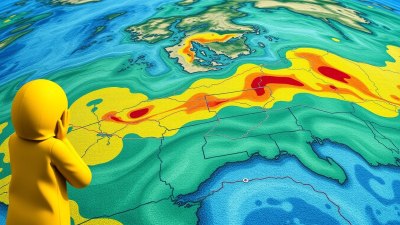How to Read People Like Weather Maps - And Avoid the Storms
Learn how to interpret people's emotions and behaviors like weather maps to navigate social interactions and avoid conflicts.

Understanding people in the complex social landscape can be as challenging as forecasting the weather. Just like meteorologists analyze atmospheric patterns to predict storms, we can learn to read people's emotions and cues to anticipate conflicts and foster healthier relationships.
The metaphor of reading people as weather maps isn't just poetic; it offers a practical framework to decode social signals and prepare ourselves for interpersonal challenges. This article will guide you through the ways to interpret emotional climates, recognize signs of tension, and respond effectively to avoid the storms that can disrupt connections.
Why Compare People to Weather Maps?
Weather maps provide a visualization of atmospheric conditions using symbols, colors, and data that help predict upcoming weather patterns. Similarly, people exhibit verbal and nonverbal cues—tone, facial expressions, body language—that serve as indicators of their internal emotional weather. By learning to identify and interpret these signs, we can anticipate mood shifts and potential conflicts.
This metaphor helps us understand that just as weather changes due to underlying forces and patterns, people's emotions fluctuate based on their environment, stressors, and personal history. Recognizing these undercurrents enables better empathy, timing, and communication.
The Elements of Emotional Weather
There are several core elements to consider when reading people like weather maps:
- Temperature: Represents the intensity of emotions. Warmth can signal friendliness and openness, whereas coldness may indicate detachment or discomfort.
- Pressure Systems: Symbolize moods or attitudes that can either be uplifting (high pressure) or oppressive (low pressure).
- Fronts: Signify transitions, such as shifts from calm to agitation or from agreement to disagreement.
- Storms and Turbulence: Reflect conflicts, emotional outbursts, or confrontations that may arise suddenly or build gradually.
By paying attention to these elements, you can form a mental picture of the person's current state and predict how interactions might evolve.
Observing Emotional Temperature: Warmth and Coldness
Temperature in human interaction is often conveyed through tone of voice, facial expressions, eye contact, and physical proximity.
A warm emotional temperature might include a genuine smile, relaxed posture, open gestures, and steady, calm speech. People exhibiting warmth are usually receptive, cooperative, and easy to engage with. Conversely, coldness might appear as crossed arms, avoidance of eye contact, clipped tone of voice, or physical distancing.
Recognizing these cues early helps you adjust your approach—perhaps by softening your tone or giving space to someone feeling 'cold.' This awareness helps in managing rapport and prevents escalation of misunderstandings.
Identifying Pressure Systems: Signs of Emotional States
In weather forecasting, high-pressure systems are associated with clear skies, while low-pressure systems bring clouds and storms. Emotional pressure systems similarly affect our interactions.
A person under 'high emotional pressure' may display signs of elevated stress, impatience, or irritability. They might speak rapidly, interrupt, or exhibit fidgeting behaviors. This signals that tensions are building and the situation could become volatile if not handled carefully.
On the other hand, 'low pressure' might appear as withdrawal, sadness, or fatigue. The person may be less communicative or disengaged, suggesting they need support or space to process their feelings.
Recognizing Fronts: Transition Points in Conversations
Fronts in weather maps mark the transition between differing air masses, often bringing changes in weather. Emotional fronts represent shifts in mood or attitude during interactions.
For example, a sudden change in facial expression—from smiling to frowning—may indicate an emotional front crossing, signaling disagreement or discomfort. Tone shifts or abrupt topic changes are also common markers.
When you notice a front, it’s important to pause, skim beneath the surface, and address any underlying concerns before the tension intensifies.
Spotting Storms and Turbulence: Predicting and Defusing Conflicts
Storms are the most obvious and challenging weather phenomena. In human dynamics, they correspond to conflicts, arguments, or emotional outbursts.
Early signs of storms include raised voices, defensive body language, sarcasm, or aggressive gestures. Just like meteorologists watch for build-ups in atmospheric pressure to warn of an approaching storm, you can observe emotional patterns to foresee escalating confrontations.
When you detect the early stages of a storm, it’s critical to respond with calmness, active listening, and empathy to de-escalate the situation. Avoid becoming defensive or combative, as this can intensify the storm.
Tools to Read Emotional Weather Effectively
Reading people like weather maps requires training your observation skills and emotional intelligence. Here are some practical tools:
- Active Listening: Pay close attention not just to words but to how things are said, noting changes in pace, tone, and volume.
- Body Language Awareness: Observe posture, gestures, facial microexpressions, and eye movements that reveal deeper feelings.
- Context Sensitivity: Consider environmental factors and recent events that might influence someone’s emotional state.
- Self-Regulation: Maintain your own calmness to better perceive others’ cues and respond appropriately.
Practicing Empathy and Emotional Resonance
Empathy is your radar for detecting emotional weather. By putting yourself in another person’s shoes, you can understand the causes of their moods and respond compassionately.
Emotional resonance means matching or adjusting your emotional energy to complement the other’s, much like a weather system balancing surrounding air masses. For example, when someone is anxious, gently lowering your tone and offering reassurance can create a safer space.
This emotional attunement prevents misunderstandings and builds trust, helping to navigate even emotionally charged conversations.
Case Examples: Reading People During Conflict
Imagine you are in a meeting and a colleague suddenly becomes curt and monosyllabic. Their 'temperature' is dropping, signaling withdrawal or irritation. Recognizing this, you might choose to ask a gentle open-ended question rather than pushing for a rapid solution, diffusing potential tension.
In another scenario, a friend’s speech quickens and gestures become sharp. This rising pressure suggests stress or agitation. Validating their feelings and offering a moment of pause can prevent escalation.
These examples demonstrate how interpreting subtle emotional weather signs empowers you to steer interpersonal dynamics away from stormy disruptions.
Developing Your Personal Emotional Weather Map
To consistently read emotional weather, develop a mental map that integrates various signals. This involves:
- Observing recurring patterns in how individuals express feelings.
- Noting triggers that shift emotional climates.
- Tracking your own emotional responses to improve objectivity.
Journaling your daily emotional observations or discussing with trusted friends or mentors can deepen your awareness and understanding.
Applications in Different Realms
This ability is invaluable across contexts—from personal relationships to professional environments. In leadership, for example, reading your team's emotional climate can guide your decisions and communication style, reducing turnover and enhancing morale.
In customer service, recognizing an irate customer’s rising storm early can help de-escalate and salvage the interaction. In families, this skill fosters harmony and emotional support.
Limitations and Ethical Considerations
While reading emotional weather provides valuable insights, it’s important not to make assumptions or judgments without sufficient information. People’s internal states are complex and sometimes concealed.
Respect privacy and boundaries; don’t pry into matters individuals aren’t willing to share. Use this skill to promote understanding, not manipulation.
Signs You Might Be Misreading Emotional Weather
If you often find yourself surprised by someone’s reactions or conflicts arise unexpectedly, it may mean your emotional radar needs recalibration. Consider seeking feedback from trusted others or developing your emotional intelligence through courses or coaching.
Additionally, your own emotional state can cloud perception, so regular self-reflection is essential.
Conclusion
Reading people like weather maps equips you with a powerful framework to navigate the emotional complexities of human interaction. By interpreting temperature, pressure systems, fronts, and storms in others’ behavior, you can anticipate changes, avoid conflicts, and enhance communication.
Like expert meteorologists, your skill will grow with observation, practice, and empathy, enabling you to create more harmonious relationships and resilient social connections.











